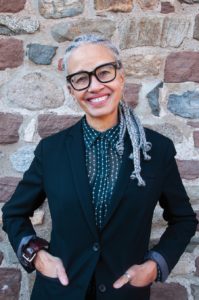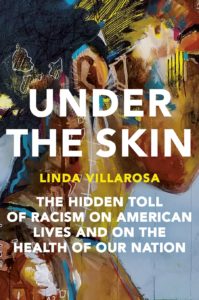Finding solutions to deep-rooted systemic injustices can seem impossible. But as Linda Villarosa writes in Under the Skin: The Hidden Toll of Racism on American Lives and on the Health of Our Nation, solutions to those problems are within our collective reach — and maybe not as impossible to achieve as we think.

An award-winning journalist who has covered the intersection of health and social justice for the New York Times Magazine, Essence, and Science Times, Villarosa will be discussing her book at the Provincetown Book Festival on Saturday, Sept. 17 in a session with novelist Dolen Perkins-Valdez.
Under the Skin looks at American history with a focus on the persistent harm that racial bias in medicine and health care inflicts on Black bodies. Villarosa’s topics range from forced sterilizations to the environmental injustices perpetrated on Black communities by corporations and government agencies. In a book so sprawling, which details so much pain over such a length of time, one might expect to lose hope.
But Villarosa doesn’t let that happen. Her approach to the material is direct and easy to follow. More important, she highlights the achievability of restorative justice through the work of individuals and communities.
A focus of Villarosa’s analysis is the persistent mythology about supposed medical differences between white and Black bodies: differences in pain tolerance, skin thickness, and lung function, all of which originated in spurious arguments used to justify enslavement and fabricate scientific “evidence” of racial inequality. Far from consigning them to the past, or assigning them to a few bad actors, Villarosa argues that they continue to be insidiously pervasive today.

She cites a 2016 study indicating that half of medical students and residents surveyed “endorsed at least one myth about physiological differences between Black and white people, including that Black people’s nerve endings are less sensitive than whites.” (Villarosa traces the origin of this myth to Thomas Hamilton, a 19th-century doctor who tortured his slave John Brown to try to prove that Black skin was somehow thicker than white.)
Villarosa draws a direct line from these discredited beliefs to current disparities in treatment: “This disconnect between what is known and what many scientists, doctors, and other medical providers — and those training to fill their positions in the future — still believe allows them to ignore their own complicity in healthcare inequality.” That racial bias leads to negative health outcomes for all Black Americans: “Money may buy good healthcare,” she writes, “but when you’re Black in America, it cannot buy good health.”
Villarosa began her research into these racial disparities when a friend cited a statistic about maternal mortality rates in the U.S.: Black women with advanced degrees were more likely to die in childbirth than white women with eighth-grade educations. Challenging her own assumption that American health-care disparities were based on class differences — and considering her own experience as the mother of a low-birth-weight infant — Villarosa set out to explore the subject in more detail. She eventually discovered that racial disparities in infant mortality “were actually greater in the present day than in 1850, when Black women were human chattel and babies of all races died so frequently that parents hesitated to name them.”
As dangerous and horrifying as those continued disparities may be, Villarosa offers hope that they are fixable. She identifies solutions in the form of community action by people like Latona Giwa, founder of the Birthmark Doula Collective in New Orleans. Giwa’s collective helps women throughout birthing, especially during those critical moments when simply listening to a woman’s symptoms can make the difference between life and death for both the mother and her infant.
Villarosa also looks at community health workers in Ethiopia, who are estimated to have saved the lives of more than 50,000 mothers and children between 2008 and 2017. In the U.S., she sees similar community-based networks as having the potential to improve health and maternity care on an even larger scale — particularly when they can better reflect the populations they serve.
It’s impossible to deny the effects of racial bias on the well-being of many people of color in the U.S. in light of the considerable evidence that Villarosa presents in Under the Skin. She offers the hope that by actively supporting community members who can advocate and care for the people they serve, everyone has the power to contribute to restorative justice.
The Truth Hurts
The event: Linda Villarosa and Dolen Perkins-Valdez in conversation at the Provincetown Book Festival
The time: Saturday, Sept. 17, 4 p.m.
The place: Provincetown Public Library, 356 Commercial St.
The cost: Free
